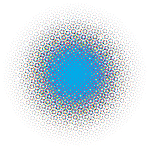Image Resolution posted December 19, 2018

At some point you may have gotten a call from your CSR stating that you have low-res images in your file.
One of the best things you can do to ensure your printed piece looks fabulous is to make sure all images are 300dpi and placed in the document at 100%. Many times, we get files that are 300dpi, but the image has been enlarged to 200% (for example), effectively making the image 150dpi. Some images will produce well at low-res, but it’s better not to risk it.

72dpi Image

Image at 300dpi.

Original 72dpi changed to 300dpi
Changing the resolution of a low-res image to a higher number doesn’t always work, either. While Photoshop has come a long way, you generally end up with an image that looks more like a watercolor painting than a photograph. But hey, maybe that’s the look you are going for!
There is some confusion between PPI and DPI. Though both describe resolution of the image, PPI describes the number of pixels that show up on the screen. DPI, on the other hand, is a printing term. It refers to the number of physical dots per inch that will print on the image.
Unfortunately, it has almost become interchangeably used in the software industry, making it even more confusing as to which is which.
Let’s talk a bit about both and try to clear up some of the confusion.
![]() Pixels are the small squares that make up images on your computer screen. If you have an image, zoom in until you start seeing squares…there ya go! Pixels!!
Pixels are the small squares that make up images on your computer screen. If you have an image, zoom in until you start seeing squares…there ya go! Pixels!!
That’s what you get when you refer to PPI, the pixels per inch represented on your screen.
The DPI, or the number of dots in an inch, determines the quality of your printed piece…in most cases, the higher the DPI, the more detail and crisper the image. 
When looked at under a printer’s loupe, the dots form what is referred to as a “rosette” pattern in traditional, offset printing.
In print, we recommend all print images be 300dpi when placed at 100%. It is better to resize really large images down to the actual size to keep file size manageable.
If we get a file that is 240dpi, we will generally run with it, as this is the standard most photographer’s use, but we will let you know that the file is under 300dpi. If an image is down to 150dpi, we will visually inspect the image or sometimes run a hi-end proof to see if the quality is acceptable and advise if we feel the final piece will be an issue.
Standard resolution for monitors and web use is 72dpi. This is perfectly acceptable in non-print applications. However, when printing, you will get less than acceptable results.
There are tools online that can help you determine DPI to finished ratio so that you can make sure your image is the proper size for print.
One last consideration, signage can sometimes be the exception to the DPI rule. If your banner or sign is going to be hanging up on a wall above heads, or in the distance, a lower DPI image may be acceptable. What looks really bad up close will sometimes look fantastic from a distance. Signage allows for less-than-perfect art, you just need to make sure the application and location are optimal.
If you have questions about your art, get in touch with your CSR. We are more than happy to take a look at it and give you feedback.